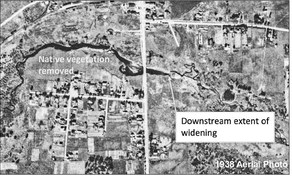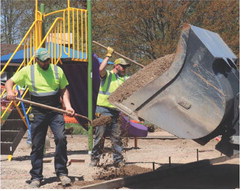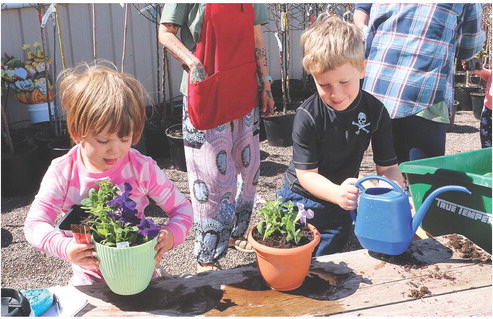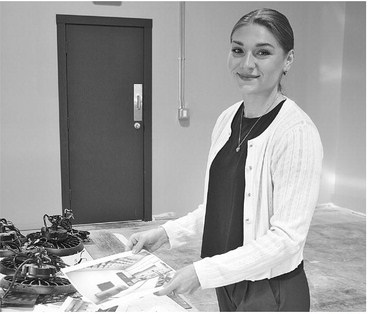Scotch Creek restoration plans in question


By Kevin O’Brien
While discussing plans to restore Scotch Creek on Monday, an engineer hired by the village of Edgar faced some pointed questions from village board members who felt like they were being asked to spend money the village doesn’t have.
“Tonight, all I saw was a bunch of numbers, some of which were very high,” said trustee Patty Schroeder-Schuett at the conclusion of a presentation by Steve Gaffield, a water resources engineer at EOR, Inc. The firm was hired by the board last fall to write the first phase of a restoration plan for Scotch Creek.
Gaffield said the $20,000 contract signed with EOR last October was just for the first phase of a plan that will likely cost as much as $100,000.
“I’m sorry if there was misunderstanding about what you were getting, and what the mission was,” he said. “That’s what was described last fall, and unfortunately, these processes take time.”
The first phase of the planning process has involved a variety of data-crunching and outreach activities, such as working with Marathon County conservation staff, hosting a tour of the watershed with local officials last November and looking up historical data about Scotch and Omar creeks.
Gaffield said it would cost between $45,000 and $60,000 to design and obtain permits for rehabilitating the half-mile stretch
See SCOTCH CREEK/ page 3 Creek
Continued from page 1
of the creek that runs through the center of the village, plus $100,000 to $200,000 for actually rebuilding and stabilizing the streambank with rocks and other materials. The overall goal would be to reverse the impacts of erosion and runoff and improve the water quality and the fishery.
Improvements have already been made to some of the land surrounding the creek. Edgar native Gordon Krall, who now lives in California, spearheaded these efforts by purchasing a seven-acre lot just north of the creek and adjacent to village land near Scotch Creek Park.
Since purchasing the land, Krall has removed several invasive species along the creek and is planning to plant about 1,000 trees and shrubs starting this week. He has also purchased solar power pavers to be installed on a boardwalk to generate monetary credits through the electric utility as a possible funding source for the project.
On Monday, the board approved a conditional use permit for Krall to install automated beehives on his property, which will supply pollinators for the newly planted flora. The solar-powered unit, created by a company called Beewise, will be monitored and maintained remotely using artificial intelligence, but service workers will also be available if needed.
Unfortunately, some of the larger-dollar grants that Krall has applied for – including $250,000 from the North American Wetlands Conservation Act (NAWCA) and $10,000 from the Wisconsin DNR’s Surface Water Grant program – have not come through. The project has been awarded a $5,000 donation from Wisconsin Public Service, and Krall has applied for funds from various private and nonprofit groups.
EOR’s presentation
Monday’s presentation by Gaffield included an overview of the Phase 1 planning work done by EOR over the past six months. Data gathered by Gaffield stretched all the way back to the 1850s when Wisconsin was first surveyed, and the width of Scotch Creek in what would become the village of Edgar was measured at approximately seven feet.
“That’s a far cry from what it is today, obviously,” he said, referring to the wider section of the creek running through modern Edgar, which is now 60 to 70 feet wide.
Gaffield said the data he gathered suggests that the replacement of native vegetation with species such as the turf grass at Scotch Creek Park has contributed to soil erosion over time. Also, because the village’s stormwater runs directly into Scotch Creek, and its tributary Omar Creek, the water is continually inundated with sediments and pollutants washed off streets.
When it comes to the fish living in the creek, Gaffield said Krall found references to trout stocking 100 years ago, but the current fishery consists mostly of minnows, shiners, chub, bullheads and some largemouth bass. A 2015 fish survey done by the DNR found species that primarily thrive in warm water and transitional temperatures, he noted.
“They were only finding small and medium-sized fish,” he said.
Trustee Jon Streit said he remembers there being a “healthy stock of northern” in the creek before the bridge was rebuilt in 1998.
“Before it was filled in, there were northerns in there, but it was also five to six feet deep under the bridge,” he said.
Gaffield said the fact that the creek has become wider and shallower over time means the water is exposed to more sunlight and warms up quicker, “like a puddle on a parking lot.”
Development within the village has changed the nature of the creek over time, but Gaffield said the degraded water quality can also be attributed to farming activities and phosphorus runoff upstream.Amap he displayed showed all of the wetlands in the watershed that have been lost over time, leading to heavier flows of water contributing to erosion and sediment buildup.
Gaffield said there may be some opportunities for rural landowners to convert some of their land back to wetlands, which would help improve the quality of the creeks.
“A lot of those former wetlands – although lost and probably being farmed – they tend not to be very profitable farmland,” he said. “They’re increasingly finding, throughout the state, farmers who are interested in other ways to use that land if it’s not profitable.”
Later in the meeting, however, Streit pointed out that many farmers are finding success by installing drain tile in former wetlands.
A turning point in the conversation came after Gaffield said it would cost an estimated $40,000 more to do additional planning in preparation for potential federal funding.
“I feel like I’m sitting through a sales pitch right now,” Streit said. “I don’t hear any updating.”
Gaffield said he was sorry if his presentation came off that way.
“I accept that criticism,” he said. “My apologies.”
When it comes to improving Scotch Creek, he identified two main areas to address: stormwater management and land use within the village itself and the impacts of agriculture upstream. EOR’s contract makes it clear that phases 2 and 3 of the restoration project would require further investment by the village.
Within the village, Gaffield said the board can look for opportunities to prevent stormwater from running into the creek, such as putting in rain gardens on the terraces whenever streets are rebuilt. He acknowledged that would be pricey.
“As you know, street construction projects are expensive, and adding in these elements is another cost to go with that,” he said. “Not to say you shouldn’t consider it, but it doesn’t seem like low-hanging fruit.”
A simpler, much less costly solution would be to encourage as many residents as possible to install rain barrels or reroute downspouts onto their lawns.
“When lots of people do it, it can make a difference, and it can prevent overwhelming storm sewer systems,” he said.
A more difficult goal would be for the village to develop relationships with rural landowners in the greater watershed and incentivize them to plant buffer strips or implement lower impact tillage to prevent phosphorus runoff.
Streit raised concerns about flooding on the south side of the creek after the last major rainfall in the village – something he has not seen before.
“It never flooded on that side, never,” he said.
Krall acknowledged that recent changes made on his land may have shifted the direction of water when the creek overflows.
“I suspect that removal of those large trees had something to do with it, because they were capturing some of that water or allowing the canopies to break some of that water down,” he said.
No further recommendations or proposals were made at Monday’s meeting.
“There’s all sorts of things you can do next,” Gaffield told the board. “You don’t have to tackle everything at once.”
87 YEAR AGO - This aerial photo shows that Scotch Creek had already widened in the village of Edgar by 1938.




